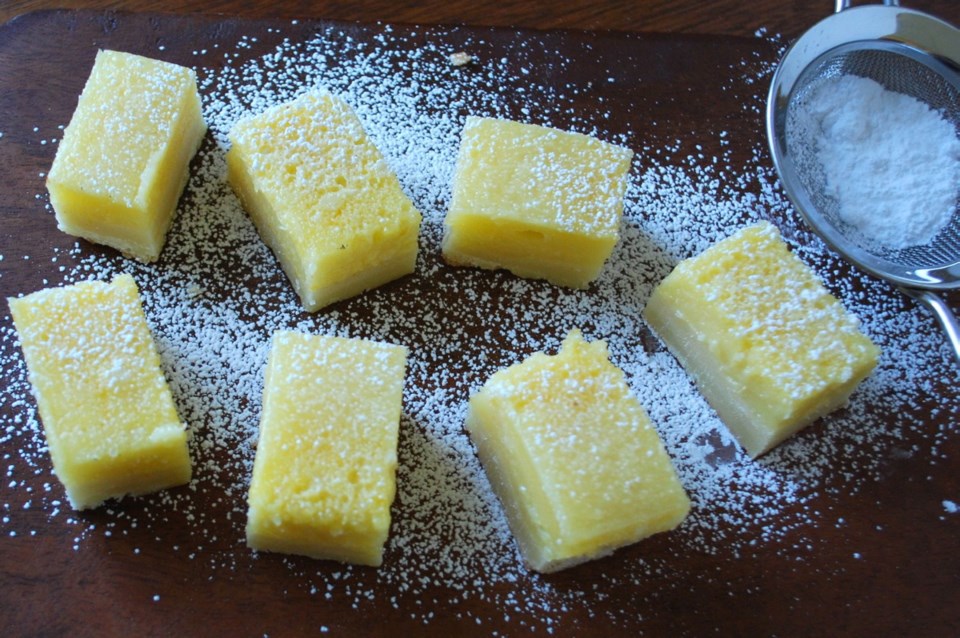 If you like juicy lemons with a��thin, edible rind, that are aromatic, not too tart and are full of culinary possibilities, you can thank Frank Meyer for the pleasure.
If you like juicy lemons with a��thin, edible rind, that are aromatic, not too tart and are full of culinary possibilities, you can thank Frank Meyer for the pleasure.
In the early 1900s, Meyer worked for the U.S. Department of Agriculture and his duties involved travelling and collecting new plant species. One trip took him to China, where he found a citrus fruit that was a cross between a lemon and a mandarin orange.
At that time in China the plant was more for home decoration, and with fairly small, eye-catching, egg-yolk-coloured fruit, that was understandable.
When introduced to U.S. it was called a Meyer lemon in Frank Meyer’s honour. Meyer never got to see it grow on his home soil, because he died in 1918 while in China.
Initially, not seeing it grow at home might have been for the best, because it took many decades for Meyer lemons to��finally be considered a jewel of��a fruit.
Because of the soft, thin rind, it��was difficult to ship Meyer lemons long distances. That meant Meyer lemons were primarily sold at farmer’s markets in and around the areas the fruit was grown, such as California.
Not a booming agricultural success, but for the reasons noted in my introduction, home cooks and chefs in places where you could buy Meyer lemons grew very fond of them and they eventually began to appear on restaurant menus.
According to a 1998 New York Times article by Amanda Hesser, one of the first places doing so was Alice Water’s famed Chez Panisse in Berkeley. In 2002, I got a taste of the fruit in that restaurant myself, when eating a dessert of pasticcini, little pastries filled with Meyer lemon-flavoured ice cream.
Not long after that, celebrities, such as Martha Stewart, also discovered Meyer lemons, and began singing their praises and publishing recipes using them.
When the fruit’s popularity exploded, growers found better ways to ship them to food stores across North America when in season, November to March. In the past few years, that has included supermarkets and specialty food stores in Victoria.
When purchasing, choose vibrantly coloured, smooth skinned, small- to medium-sized Meyer lemons (large ones have thicker skins) heavy for their size. In good condition, they’ll keep at cool room temperature up to two weeks. If you need to store them longer than that, refrigerate them.
I use Meyer lemons on just about everything that can use a refined, tangy boost, such as roast chicken, seafood and today’s salad dressing recipe. I also use Meyer lemon to flavour drinks and desserts, such as cakes, custard and today’s square recipe. In California, I even tried Meyer lemon on a pizza, which inspired today’s first recipe.
Meyer Lemon Pizza with Prosciutto and Goat Cheese
Tangy, salty, creamy and herbaceous tastes come together in this��splendid pizza. Be sure to slice the Meyer lemon as thinly as��you can. If too thick, it won’t soften and meld with the other flavours in the pizza and will be more difficult to bite through.
Preparation: 40 minutes, plus rising time
Cooking time: 12 to 13 minutes
Makes: One (12-inch) pizza
��
2/3 cup luke warm (not hot) water
1 tsp traditional (active dry) yeast
1/2 tsp granulated sugar
1 Tbsp extra virgin olive oil, plus some for the bowl, pan and drizzling
1 1/2 cups all-purpose flour
1/4 tsp salt
1/2 cup whipping cream
1 small garlic clove, minced
1/4 tsp. coarsely ground black pepper
1 Meyer lemon, sliced very, very thinly, any seeds removed
3 to 4 long, paper-thin slices of prosciutto, pulled into smaller pieces
50 to 75 grams soft goat cheese, pulled into small nuggets
8 to 12 whole fresh basil leaves, larger ones torn into smaller pieces
��
In the bowl of your stand mixer fitted with a dough hook, combine the water, yeast, sugar and 1 Tbsp oil. Let the mixture stand five minutes, until the yeast is dissolved.
Add the flour and salt and mix��on medium until the dough is��smooth and just pulls away from the sides of the bowl. (The dough is meant to be fairly soft.) Knead the dough five minutes.
Lightly grease a bowl with olive oil. Place the dough in the bowl. Cover with plastic wrap and let rise at warm room temperature until doubled in size, about 75��minutes.
Place the cream, garlic and pepper in a small pot. Bring just to a simmer over medium-high heat. Now remove from the heat and let cream mixture cool to room temperature.
While the cream is cooling, lightly oil a 12-inch non-stick pizza��pan. Set the dough on the pan and gently press, push and spread it until it reaches the edges of the pan. Let the dough rest in the pan a few minutes. If the dough contracts, press on it again until it reaches the outer edges again.
Place the oven rack in the lower third of your oven. Preheat the oven to 450 F. Spread the top of the pizza dough with the cream mixture. Top the cream with prosciutto and goat cheese, and then set on the lemon slices.
Bake the pizza 12 to 13 minutes, or until puffed and golden and crisp on the sides and bottom.
Remove pizza from the oven and let set two minutes. Now carefully slide onto a cutting board. Top pizza with the fresh basil, slice and serve.
��
Meyer Lemon Vinaigrette
Use this tangy, refreshing vinaigrette to dress baby lettuces, spinach, arugula and other salad greens. You could also spoon it in on raw oysters, or cooked, chilled mussels on the half shell.
Preparation: a few minutes
Cooking time: none
Makes: About 3/4 cup
��
1/2 tsp finely grated Meyer lemon zest
3 Tbsp Meyer lemon juice
2 tsp Dijon mustard
1 1/2 tsp honey
1/2 tsp dried tarragon
1/2 cup olive oil
• salt and freshly ground black pepper, to taste
Place all ingredients in a small jar and put on the lid. Shake the jar to create emulsified vinaigrette. Taste the dressing and adjust seasoning, if needed.
Refrigerate vinaigrette until needed. It will keep at least a week. Shake the vinaigrette again just before using.
Meyer Lemon Shortbread Squares
Rich shortbread topped and baked with a tangy Meyer lemon mixture. These squares make a nice teatime treat.
Preparation: 20 minutes
Cooking time: 45 minutes
Makes: 24 squares
��
• soft butter or vegetable oil spray
1 1/2 cups all-purpose flour
1/2 cup icing sugar
3/4 cup butter, cut into cubes and warmed to room temperature
4 large eggs, beaten
1 1/4 cups granulated sugar
• finely grated zest of 1 meyer lemon
1/2 cup fresh Meyer lemon juice (juice from about 4 to 5 lemons)
1/2 cup all-purpose flour
• icing sugar, for dusting
Preheat oven to 350 F. Lightly grease an eight-inch square baking pan with the soft butter or oil spray. Cut an 8- by 12-inch piece of parchment paper to fit the bottom and up two of the four sides of that pan and set it there. (The parchment paper extending the sides of��the pan will later be used as handles to lift the square out of the pan once baked.)
Place the 1 1/2 cups flour, icing sugar and 3/4 cup butter in a medium bowl and with a pastry cutter, two forks or your fingers, mix until crumbly. Transfer mixture to the pan and press into an even layer.
Bake the shortbread crust 15 minutes. While the crust bakes, prepare topping by placing the eggs, granulated sugar and zest and juice in a second bowl and whisk untilwell combined. Now whisk in the 1/2 cup flour.
When the crust has baked 15 minutes, remove from the oven. Reduce the oven to 325��F. Pour the Meyer lemon mixture over the shortbread crust.
Set the square back in the oven and cook until the��Meyer lemon mixture is��set, about 30 minutes. Cool��the square on a rack to��room temperature. Cover and refrigerate, until needed.
To serve, use a paring knife to loosen the square from the edges of the pan. Grab on to the parchment and lift the square out of the pan onto a work surface. Cut into squares, set on a serving plate, dust with icing sugar and enjoy.
Eric Akis is the author of��The Great Rotisserie Chicken Cookbook. His columns appear in the Life��section Wednesday and��Sunday.
��



